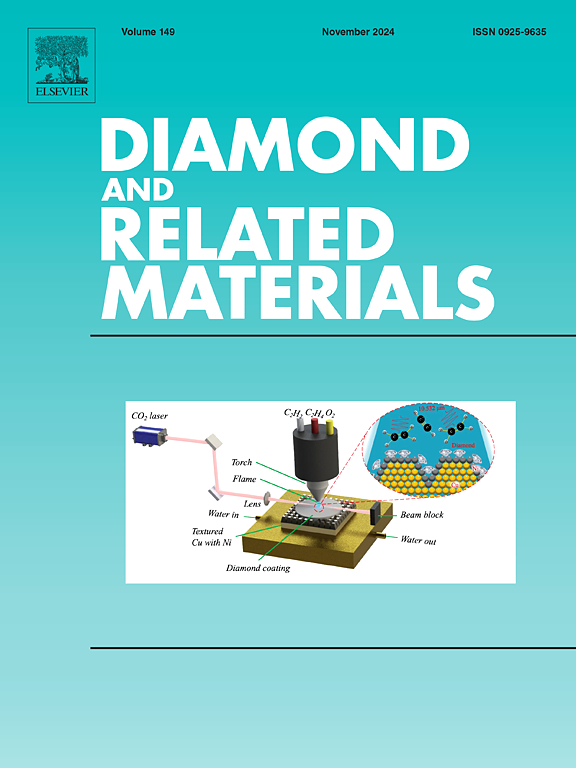Facile glucose oxidase immobilization onto amino-functionalized multi-walled carbon nanotubes for glucose detection
IF 5.1
3区 材料科学
Q2 MATERIALS SCIENCE, COATINGS & FILMS
引用次数: 0
Abstract
Glucose detection is crucial in food processing, pharmaceuticals, and clinical diagnostics. To enhance the performance of glucose detection, enzyme immobilization has emerged as a key strategy that improves enzyme stability and reusability. Multi-walled carbon nanotubes (MWCNTs) have served to immobilize enzymes and fabricate electrochemical biosensors due to their physicochemical properties. Here, MWCNTs were amino-functionalized through an effective and easy three-step chemical reaction (hydroxylation, chlorination, and amination). Then, glucose oxidase (GOx) was immobilized onto MWCNTs-NH2 modified glassy carbon electrode (GOx/MWCNTs-NH2/GCE) to construct an enzymatic glucose biosensor. The chemical, structural, and morphological characteristics of MWCNTs-NH2 were confirmed through various analytical techniques, including Fourier transform infrared spectroscopy (FT-IR), thermogravimetric analysis (TGA), energy-dispersive X-ray (EDX) spectroscopy, field emission scanning electron microscopy (FE-SEM), and atomic force microscopy (AFM). The electrochemical behavior of GOx/MWCNTs-NH2/GCE was examined using cyclic voltammetry (CV), electrochemical impedance spectroscopy (EIS), and differential pulse voltammetry (DPV). CV voltammogram of GOx/MWCNTs-NH2/GCE shows redox peaks with formal potential (E°′) of −0.446 V related to immobilized GOx. Also, the kinetics parameters including electron transfer rate constants (ks) were determined as 5.94 s−1. Moreover, GOx/MWCNTs-NH2/GCE was used for glucose biosensing via the DPV method with the linear range 1.9–49.5 μM along with the limit of detection (LOD) and sensitivity of 0.75 μM and 1143 μA mM−1 cm−2, respectively. In real samples of orange, apple, and pineapple fruit juices, glucose was measured as 2.30, 1.58 and 1.64 gL−1, respectively. This biosensor provides an appropriate platform for glucose determination and purpose MWCNTs-NH2 as a candidate to immobilize biological molecules.

氨基功能化多壁碳纳米管固定化葡萄糖氧化酶用于葡萄糖检测
葡萄糖检测在食品加工、制药和临床诊断中至关重要。为了提高葡萄糖检测的性能,酶固定化已成为提高酶稳定性和可重用性的关键策略。多壁碳纳米管(MWCNTs)由于其物理化学性质而被用于固定化酶和制造电化学生物传感器。在这里,MWCNTs通过有效且简单的三步化学反应(羟基化、氯化和胺化)被氨基功能化。然后,将葡萄糖氧化酶(GOx)固定在MWCNTs-NH2修饰的玻碳电极(GOx/MWCNTs-NH2/GCE)上,构建酶解葡萄糖生物传感器。通过傅里叶变换红外光谱(FT-IR)、热重分析(TGA)、能量色散x射线(EDX)光谱、场发射扫描电镜(FE-SEM)和原子力显微镜(AFM)等多种分析技术证实了MWCNTs-NH2的化学、结构和形态特征。采用循环伏安法(CV)、电化学阻抗谱(EIS)和差分脉冲伏安法(DPV)研究了GOx/MWCNTs-NH2/GCE的电化学行为。GOx/MWCNTs-NH2/GCE的CV伏安图显示,氧化还原峰的形式电位(E°')为- 0.446 V,与固定化GOx有关。动力学参数包括电子转移速率常数(ks)为5.94 s−1。利用GOx/MWCNTs-NH2/GCE在线性范围为1.9 ~ 49.5 μM的DPV法检测葡萄糖,检测限(LOD)和灵敏度分别为0.75 μM和1143 μA mM−1 cm−2。在橙汁、苹果汁和菠萝汁的实际样品中,葡萄糖的测量值分别为2.30、1.58和1.64 gL−1。这种生物传感器为葡萄糖测定提供了一个合适的平台,并将MWCNTs-NH2作为固定化生物分子的候选物。
本文章由计算机程序翻译,如有差异,请以英文原文为准。
求助全文
约1分钟内获得全文
求助全文
来源期刊

Diamond and Related Materials
工程技术-材料科学:综合
CiteScore
6.00
自引率
14.60%
发文量
702
审稿时长
2.1 months
期刊介绍:
DRM is a leading international journal that publishes new fundamental and applied research on all forms of diamond, the integration of diamond with other advanced materials and development of technologies exploiting diamond. The synthesis, characterization and processing of single crystal diamond, polycrystalline films, nanodiamond powders and heterostructures with other advanced materials are encouraged topics for technical and review articles. In addition to diamond, the journal publishes manuscripts on the synthesis, characterization and application of other related materials including diamond-like carbons, carbon nanotubes, graphene, and boron and carbon nitrides. Articles are sought on the chemical functionalization of diamond and related materials as well as their use in electrochemistry, energy storage and conversion, chemical and biological sensing, imaging, thermal management, photonic and quantum applications, electron emission and electronic devices.
The International Conference on Diamond and Carbon Materials has evolved into the largest and most well attended forum in the field of diamond, providing a forum to showcase the latest results in the science and technology of diamond and other carbon materials such as carbon nanotubes, graphene, and diamond-like carbon. Run annually in association with Diamond and Related Materials the conference provides junior and established researchers the opportunity to exchange the latest results ranging from fundamental physical and chemical concepts to applied research focusing on the next generation carbon-based devices.
 求助内容:
求助内容: 应助结果提醒方式:
应助结果提醒方式:


